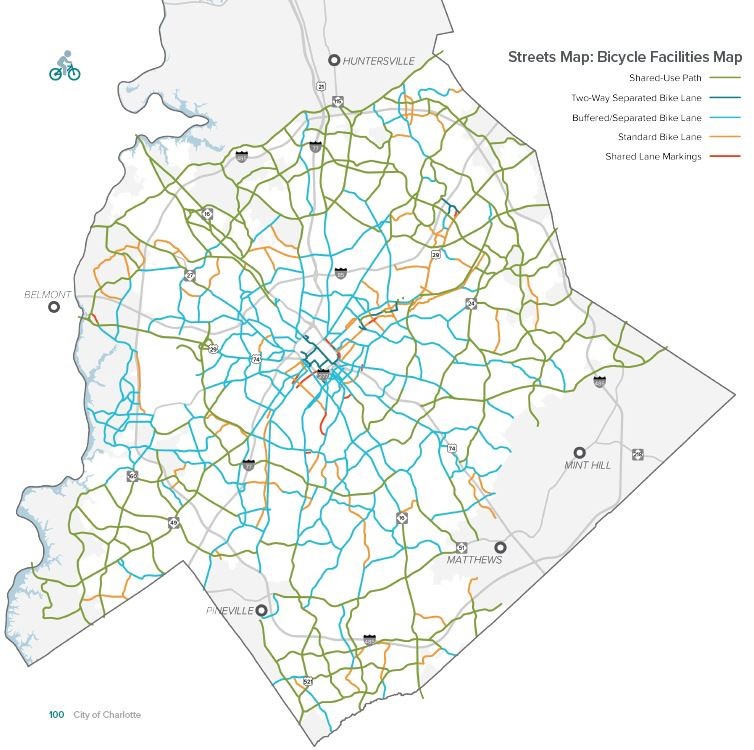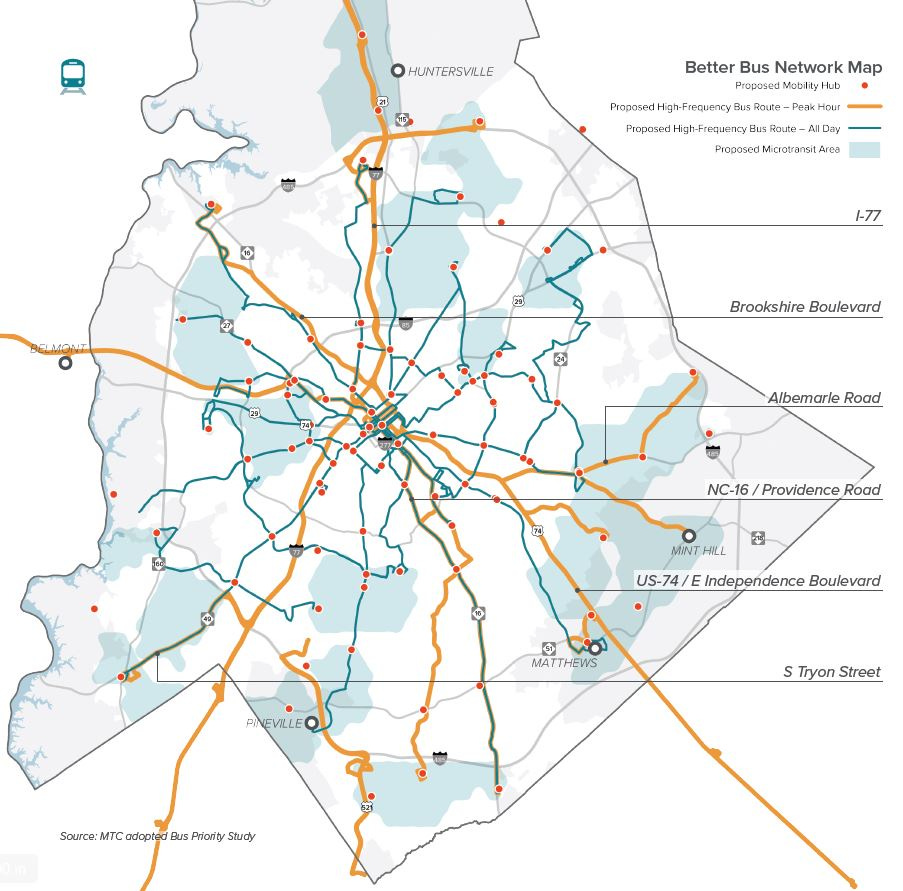You’re reading Transit Time, a weekly newsletter for Charlotte people who leave the house. Cars, buses, light rail, bikes, scooters … if you use it to get around the city, we write about it. Transit Time is produced in partnership among The Charlotte Ledger, WFAE and the UNC Charlotte Urban Institute.
The Strategic Mobility Plan adopted this week has ‘lofty goals’ — and is packed with fascinating info about driving, biking, greenways and more. Let’s geek out, shall we?
By Ely Portillo
A far-reaching new plan could shape Charlotte’s transportation infrastructure for decades to come, reorienting a car-dependent, sprawling Southern city towards a denser, transit-oriented, bike- and pedestrian-friendly future.
Charlotte City Council approved the Strategic Mobility Plan on Monday in a 9-2 vote, with council members Tariq Bokhari and Ed Driggs voting no. The plan was developed alongside the new Unified Development Ordinance and 2040 Vision Plan, one of a slew of new policies being developed as Charlotte wrestles with growth and growing pains.
“It’s got some lofty goals in it. But as a city, I think we can aspire to lofty goals,” said council member Greg Phipps. “I do wonder how long it will take to transform the mindset of people wanting to get in their cars, and rely on them less and less. That’s going to be a challenge.”
But the Strategic Mobility Plan isn’t just an outline of policies meant to guide future growth — it’s also a rich trove of data and analysis on the state of Charlotte’s transportation system. For people who like to nerd out on transit and transportation infrastructure, the 164 pages are full of nuggets to unpack.
After reading through the plan (reading government plans the size of a novella is one of our favorite pastimes), here are some highlights besides the already much-rehashed plans for the Silver Line, Gold Line and other transit programs. (And a hat tip to local cyclist and advocate John Holmes, who went through some of these on Twitter a few weeks ago).
Making fewer trips
The Strategic Mobility Plan’s most ambitious goal is for Charlotteans to use something besides a car for half of all trips by 2040. For comparison, more than three-quarters of people in Charlotte currently drive to work alone.
While there’s been a lot of attention paid to building other ways for people to get around — more transit, greenways, sidewalks, bike lanes — one of the less-discussed goals of the plan is even more fundamental: reducing trips altogether.
“While investing in multimodal transportation choices is necessary, our mode share goal cannot be reached without also reducing travel demand,” the plan states. Other parts call for Charlotte to “reduce per capita VMT [vehicle miles traveled].” It might sound counterintuitive in a mobility plan, but a major goal is to get people to move less, or at least not as far.
The underlying reason is pretty simple: With Charlotte sprawling over roughly 310 square miles, most people have to drive, and drive pretty far, to get to work, buy groceries and go about their lives. The median commute to work (pre-Covid, anyway) is about 25 minutes each way.
You’re a lot more likely to walk a half-mile to get a coffee than you are to walk three miles, but many neighborhoods don’t have any retail or services nearby. And if people don’t have to drive as much and as far, Charlotte might just reach its 50/50 goal.
Land use is key: There’s little chance of reducing travel demand without changing our land use policies to encourage more density, so people don’t have to drive so far for their daily needs. So, keep in mind as you read the Strategic Mobility Plan: It’s as much about land use as it is about transportation, and none of it works without different development patterns.
Why people choose transportation modes
The Strategic Mobility Plan includes survey results from thousands of Charlotteans the city asked about how they get around — and why they choose to drive, walk, take transit or bike — offering deeper insight into the city's attitudes towards transit.
Tougher to travel: 51.2% of Charlotteans think travel has become more difficult in the past few years, while 13.3% said travel is easier and 35.5% said it’s about the same.
Parking dominates decisions: “Ease of parking” is the key to how people make decisions about how to travel in Charlotte, with 62% of respondents identifying that as the most important factor. You can read that two ways: that building less parking and making it less convenient to park is an essential step to get people to ditch their cars, or that Charlotte’s not ready for car-free and car-lite developments.
Driving favored: Driving is still seen as the easiest way to get around, with 80.1% of respondents saying driving is “very easy” or “somewhat easy.” The bus, by contrast, is seen as easy by only 14.1% of respondents, with 47.9% saying it’s “not easy” and 38.1% saying they don’t know enough about using the bus to say.
Barriers to walking: The two biggest barriers to walking are “not enough sidewalks or crosswalks” (59.8%) and “destinations are too far” (55.7%).
Biking barrier: The single biggest barrier to biking was identified as “Bikeways do not feel safe or comfortable for people of all ages and abilities” (71.2%).
Transit barriers: For transit, the biggest barriers are “Convenience/access to nearby transit stops” (59.8%) and “Routes don’t take me where I need to go” (56.6%). Interestingly, “Service isn’t frequent enough” was identified as a barrier by only 29.1% of respondents.
Redesigning streets: When asked whether they agree streets should be redesigned for “all users” (not just cars), almost 90% of respondents agreed. But when the same question was asked with “EVEN if it would increase automobile congestion during peak hours” added, support dropped to about 61%.
Commuting: Even after the pandemic ends, 65.2% of respondents anticipate driving to work in their personal vehicles. The proportion of people planning to take public transportation dropped from 8.6% pre-pandemic to 7.9%; the share of people planning to work from home more than doubled, but remained at only 11%.
Other data
The plan is a trove for all kinds of stats. Among them:
Transit demographics: Bus riders in Charlotte (the majority of all riders) are overwhelmingly people of color: 78% are African American. Of those riders, 63% use transit for commuting to work and 47% earn less than $25,000 a year. The Blue Line light rail ridership is also majority people of color: 71% are African American, 63% use the rail for commuting to work, and 45% earn $25,000–$49,999 per year.
Flooded greenways: Greenways, which make up the bulk of Charlotte’s protected bike infrastructure, follow creeks and are susceptible to floods. “A recent analysis by CDOT revealed that the City loses as much as 44 miles (or 24%) of its bike network after significant rain events. The impacts to those segments can last for days until floodwaters recede and sedimentation/debris is cleared,” the plan notes. That’s expected to be a bigger challenge as climate change makes heavy storms more frequent.
Driving costs: It costs the average household $15,719 a year to drive in Charlotte. Transportation accounts for 22% of the average household’s income.
E-scooters: Since e-scooters debuted four years ago, Charlotte riders have covered 4.1 million miles.
And let’s not forget all the maps
A mobility plan wouldn’t be much without some maps. Here, you can take a glimpse at what Charlotte plans to build in the future — at least, if funding can be found.
Bike map: new bike lanes or paths
Road Map: new streets
Bus Map: proposed bus routes
Go even deeper: You can read the whole plan yourself on the city of Charlotte’s website.
Ely Portillo is assistant director at the UNC Charlotte Urban Institute. He previously spent a decade as a reporter at The Charlotte Observer.
In brief…
New source eyed for road funding: A proposal for North Carolina’s budget developed by Republican legislative leaders calls for beefing up transportation funding by shifting revenue from sales taxes. State leaders have been grappling with declining revenues from gas taxes as motorists switch to electric vehicles. The proposal would redirect 2% of sales tax receipts in 2023, or about $193 million, and then ramp up to 6% in later years and produce an estimated $628 million by 2025. The gas tax brought in $1.9 billion in 2020. (N.C. Tribune, subscriber-only)
Tolls delayed on Independence: Plans to build toll lanes on Independence Boulevard have been pushed back by four years, with work now estimated to start in 2030. A spokeswoman for the N.C. Department of Transportation said it “is not a cash balance issue, but a programming issue due to the cost escalation many industries are experiencing.” (Observer, subscriber-only)
Scooters for Matthews: Fifty Bird scooters will be available for use in Matthews starting Friday. Matthews’ mayor said: “Matthews is joining a global community of more than 350 cities who have chosen to offer residents and visitors a new, environmentally friendly way to explore their area.” (South Charlotte Weekly)
CATS shares driver absences: The Charlotte Area Transit System has started revealing bus driver absences in daily Twitter posts that started last week. In that period, between 56 and 107 drivers were absent each day. The system needs 292 drivers to operate efficiently on a weekday and has a total of 497 drivers on staff. CATS CEO John Lewis said last week that unexcused absences, along with difficulty hiring drivers, has led to unreliable service. (Axios Charlotte)
No bus, no job: A CATS bus rider told WBTV that she lost her job because buses were too unreliable. “Oh yes, yes, yes, yes. In fact, I lost a job before,” said Tina Quizon. She said she had no way to get to work on time: “In the evening, there’d be no bus. I’d have to walk 45 minutes in the dark home.” (WBTV)
Transit Time is a production of The Charlotte Ledger, WFAE and the UNC Charlotte Urban Institute. You can adjust your newsletter preferences on the ‘My Account’ page.
Did somebody forward you this newsletter and you need to sign up? You can do that here:
Other affiliated Charlotte newsletters and podcasts that might interest you:
The Charlotte Ledger Business Newsletter, Ways of Life newsletter (obituaries) and Fútbol Friday (Charlotte FC), available from The Charlotte Ledger.
The Inside Politics newsletter, available from WFAE.
The UNC Charlotte Urban Institute newsletter and the Future Charlotte podcast from the Urban Institute.









